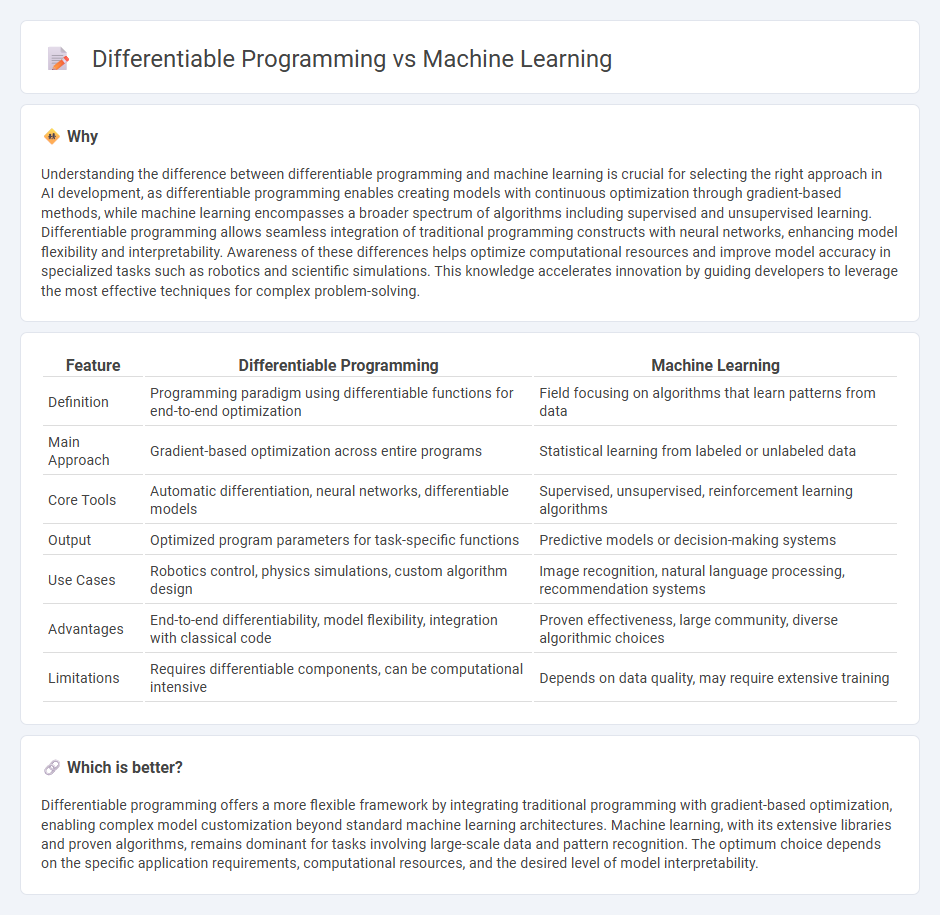
Differentiable programming integrates neural networks and traditional programming by enabling seamless gradient-based optimization across entire systems, enhancing adaptability and precision in solving complex problems. Machine learning focuses on developing algorithms that enable computers to learn from data patterns and improve performance on specific tasks without explicit instructions. Explore the key differences and applications of differentiable programming and machine learning to understand their distinct roles in advancing technology.
Why it is important
Understanding the difference between differentiable programming and machine learning is crucial for selecting the right approach in AI development, as differentiable programming enables creating models with continuous optimization through gradient-based methods, while machine learning encompasses a broader spectrum of algorithms including supervised and unsupervised learning. Differentiable programming allows seamless integration of traditional programming constructs with neural networks, enhancing model flexibility and interpretability. Awareness of these differences helps optimize computational resources and improve model accuracy in specialized tasks such as robotics and scientific simulations. This knowledge accelerates innovation by guiding developers to leverage the most effective techniques for complex problem-solving.
Comparison Table
| Feature | Differentiable Programming | Machine Learning |
|---|---|---|
| Definition | Programming paradigm using differentiable functions for end-to-end optimization | Field focusing on algorithms that learn patterns from data |
| Main Approach | Gradient-based optimization across entire programs | Statistical learning from labeled or unlabeled data |
| Core Tools | Automatic differentiation, neural networks, differentiable models | Supervised, unsupervised, reinforcement learning algorithms |
| Output | Optimized program parameters for task-specific functions | Predictive models or decision-making systems |
| Use Cases | Robotics control, physics simulations, custom algorithm design | Image recognition, natural language processing, recommendation systems |
| Advantages | End-to-end differentiability, model flexibility, integration with classical code | Proven effectiveness, large community, diverse algorithmic choices |
| Limitations | Requires differentiable components, can be computational intensive | Depends on data quality, may require extensive training |
Which is better?
Differentiable programming offers a more flexible framework by integrating traditional programming with gradient-based optimization, enabling complex model customization beyond standard machine learning architectures. Machine learning, with its extensive libraries and proven algorithms, remains dominant for tasks involving large-scale data and pattern recognition. The optimum choice depends on the specific application requirements, computational resources, and the desired level of model interpretability.
Connection
Differentiable programming enables seamless integration of gradient-based optimization within machine learning models, allowing for efficient end-to-end training of complex neural networks. Machine learning algorithms leverage differentiable programming to compute gradients automatically, facilitating improved model accuracy and faster convergence. This connection enhances adaptability in applications like computer vision, natural language processing, and reinforcement learning.
Key Terms
Model Training
Machine learning primarily relies on gradient-based optimization techniques to iteratively update model parameters during training, leveraging large datasets to improve predictive accuracy. Differentiable programming extends this by embedding differentiable components within programs, allowing for more flexible end-to-end gradient computations that optimize entire systems beyond traditional models. Explore deeper insights into the nuances of model training in these paradigms to enhance your understanding.
Gradient Descent
Gradient descent forms the backbone of both machine learning and differentiable programming by iteratively minimizing loss functions through parameter updates. In machine learning, it is primarily employed to optimize model parameters within fixed architectures, while differentiable programming extends this process across entire programs, enabling end-to-end optimization of diverse and dynamic systems. Explore deeper insights into how gradient descent drives innovation in both domains.
Automatic Differentiation
Automatic Differentiation (AD) is a core technique in differentiable programming that enables efficient and exact gradient computation by breaking down complex functions into elementary operations and applying the chain rule. While machine learning models frequently employ AD for optimizing neural networks, differentiable programming extends this concept, allowing gradient-based optimization across broader programmatic constructs, including loops and conditional statements. Explore the potential of Automatic Differentiation to deepen your understanding of advanced computational optimization.
Source and External Links
What Is Machine Learning (ML)? - IBM - Machine learning is a branch of artificial intelligence that enables computers to learn from data using methods like supervised learning (with labeled data), unsupervised learning (with unlabeled data), and models to discover patterns and make predictions.
Machine Learning: What it is and why it matters - SAS - Machine learning automates analytical model building and includes key methods such as supervised learning, which uses labeled data for prediction, and unsupervised learning, which explores patterns in unlabeled data for tasks like clustering and segmentation.
What is Machine Learning? Definition, Types, Tools & More - Machine learning is a subset of AI involving algorithms that improve from experience, typically following steps of data collection, preprocessing, and model training to transform raw data into actionable insights.
 dowidth.com
dowidth.com